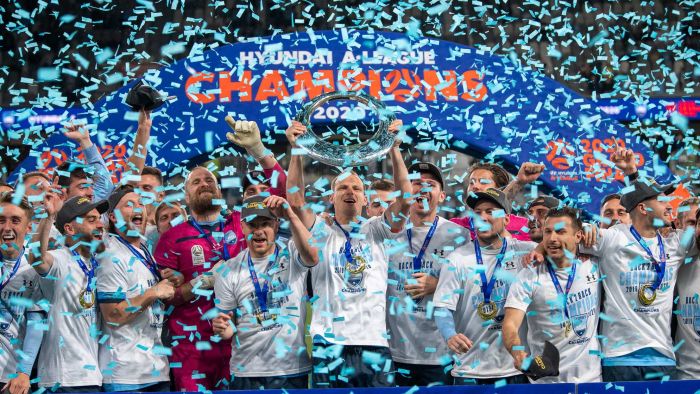After years of negotiation, the A-League and W-League clubs are stepping out on their own.
The recently rebranded Football Australia has relinquished full control over the professional football competitions it has run since its foundation in 2005, handing over the commercial reins to the 12 A-League clubs.
It’s a move that will bring the game into line with major competitions around the world, and club bosses say the “handbrake is off” and they are ready to take advantage.
Here’s what it means for the clubs and their fans.
How will it work?
Defined as an “unbundling” in the New Year’s Eve announcement, the A-League, W-League and the Y-League will be run by a new board called the Australian Professional Leagues (APL).
The APL will be given “operational, commercial and marketing control” of the competitions and will be given all responsibility for earning money.
In short, it means your club will have a lot more independence to choose its own path, in everything from financial matters to the logo and marketing — the safety net of Football Australia will be gone, but many clubs will see an opportunity to forge their own path.
The separation has been approved by the Football Australia board and each club.
The APL board will be made up of five club directors, three independent directors and one Football Australia appointee.
The clubs will elect the chair, which will be ratified by the governing body, while Greg O’Rourke, currently head of the professional competitions at Football Australia, will be the game’s new commissioner.
Why do the clubs want to do this?
The clubs believe the separation from the national governing body will help the competition’s long-term viability.
The owners who have been pumping money into the competition since its inception, mostly wealthy business owners or global corsortiums, will now have more say in how the competition is run and can seek outside investment.
Currently, the A-League is without a naming rights sponsor after ending its long-term association with Hyundai, and many clubs have struggled through the coronavirus pandemic.
Independent competitions are not uncommon in the football world.
Many of the world’s top competitions like the English Premier League, Spanish La Liga and German Bundesliga are separate of their national associations.




Football Australia chief executive James Johnson said the newly developed model would be more in line with that used in Korea and Japan than the Premier League, but would cater to local challenges and preferences.
Paul Lederer, chair of the APL and the Western Sydney Wanderers, said “innovation” would be at the heart of the APL’s push to generate more income, hinting at catering to rapidly changing viewing tastes.
He said the clubs had been waiting a long time for this, but would now need to deliver.
“The handbrake on the game is off; owners can finally invest in what they own and create value for the entire footballing ecosystem,” he said.
Independent elite sporting competitions are not unprecedented in Australian sport either.
The NBL de-merged from Basketball Australia in 2013, and Melbourne businessman Larry Kestelman took ownership in 2015, overseeing a growth in crowds, expansion teams and linkages with the National Basketball Association.
Will Football Australia still be involved?




Similar to the models in other countries, Football Australia will still have an important role as a competition regulator.
It will oversee disciplinary and integrity issues, registration of clubs, players and officials, the transfer system and the draw.
Football Australia will also retain the final say over expansion, contraction or the long-desired creation of promotion/relegation, and controls access to the Asian Champions League, FFA Cup and other domestic and international competitions.
Separate from its regulatory role, the governing body also retains a ‘golden share’ financial stake in the APL, granting it some veto rights on the board.
Do we know what will change?
Lederer said the game would be run “quite a bit” differently, and said there would be a focus on commercial growth and improving the business model of the game.
In regard to expansion, Lederer said they would ideally like to expand to 14 or 16 clubs, provided they could find the right owners, but Football Australia retains the right to accept or reject new teams.
Johnson said there was a likely reform of the player transfer system coming in the new year.
What the football bosses said won’t change is the involvement of the Wellington Phoenix, nor their commitment to women’s football.




How did this separation come about?
The struggle for control over the future direction of the A-League has been brewing for years.
The owners of the clubs had been seeking more influence and power over decision-making, but the moves had been resisted by former chairmen Frank and Steven Lowy.
The turning point came in 2018.
A working group backed by international governing body FIFA recommended some corporate governance changes to the Australian game, among them an expansion of the congress and a look at an independent A-League.
FIFA threatened it could suspend Australia’s membership if the changes were not voted in.
But former chairman Steven Lowy said handing more power to the elite competitions would not be in the best interests of the game and would come at the detriment of the grassroots level.
The reforms were passed and Steven Lowy departed, handing over to Chris Nikou, who had backed the working group’s reforms.
An in-principle deal was struck between the two groups in July 2019 and they have been ironing out the legalities since.
Lederer said while the sides were now separated, they needed to work together for the benefit of the game.







